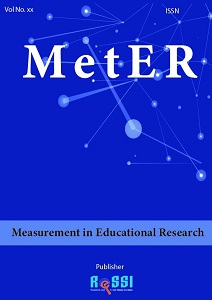Content validity and reliability of instruments for evaluating culinary skills teaching factory programs
DOI:
https://doi.org/10.33292/meter.v3i2.239Keywords:
Teaching factory, Quest, Coffee shop, CIPP, KulinerAbstract
This research aims to develop an evaluation instrument for the teaching factory (TEFA) program for culinary expertise competence at SMKN 6 Yogyakarta. Instruments developed based on the CIPP evaluation model (Context, Input, Process, Product). Research methods using instrument development stages refer to test development procedures according to Oriondo & Dallo-Antonio: (1) test design, (2) trials, (3) determination of validity, and (4) determination of reliability. The sample used was 120 class XI Culinary students for the academic year 2023/2024 in the environment of SMKN 6 Yogyakarta. Polytome data were analyzed with the Partial Credit Model using the Quest program. The results showed that as many as ten items of evaluation instruments fit with the model. The reliability value of the instrument is 0.78. This means that the reliability of the instrument is in the high category. The results of content and construct validation state that all items (16 items) are suitable to be used to evaluate the culinary competence teaching factory (coffee shop) program at SMKN 6 Yogyakarta. Â
References
Anggia, D. (2020). The implementation of teaching factory to improve student interest in entrepreneurship at multimedia competencies. JOURNAL OF TECHNOLOGY AND HUMANITIES, 1(2), 42–50. https://doi.org/10.53797/jthkkss.v1i2.1.2020
Abdurrahman, S., &; Kibtiyah, A. (2021). Strategies to overcome student learning difficulties by understanding student learning styles (case study in Ma Al-Ahsan Bareng). Tambusai Education Journal , 5(3).
Bahri, S. (2022). Improving the quality of management of islamic educational institutions through human resources in the pandemic era. Munaddhomah: Journal of Islamic Education Management, 3(1), 43–56. https://doi.org/10.31538/munaddhomah.v3i1.158
Bruner, J. (1960). The process of education. . Harvard University Press.
Cahyaningrum, N., & Hery, A. (2020). Implementation of learning teaching factory clothes SMK N 3 Malang. 2nd International Conference on Social, Applied Science, and Technology in Home Economics.
Diwangkoro, E., & Soenarto, S. (2020). Development of teaching factory learning models in vocational schools. Journal of Physics: Conference Series, 1456(1). https://doi.org/10.1088/1742-6596/1456/1/012046
Fajaruddin, S., Retnawati, H., Wijaya, T. T., Ramadhan, S., &; Prihatni, Y. (2021). Alhamdulillah, the items for the development of scientific journal article assessment instruments are said to be valid by raters. Measurement In Educational Research (Meter), 1(2), 89. https://doi.org/10.33292/meter.v1i2.156
Huda, S. T., &; Susdarwono, E. T. (2023). The relationship between Piaget's Theory of Cognitive Development and Bruner's Theory of Learning. Journal of Basic Education Muassis, 2(1), 54–66.
Istiyono, E. (2020). Development of assessment instruments and analysis of physics learning outcomes with classical and modern test theory (Second Printing). UNY Press.
Kho, A. R. J., & Tom, S. (1996). Acer quest version 2.1. Camberwell,. The Australian Council for Educational Research.
Mardhiyah, R. H., Aldriani, S. N. F., &; Chitta, F. (2021). The importance of learning skills in the 21st century as a demand in human resource development. Lectura: Journal of Education, 12(1), 29–40. https://doi.org/10.31849/lectura.v12i1.5813
Mukhlason, A., Winanti, T., &; Yundra, E. (2020). Analysis of SMK Indicators contributing to unemployment in East Java Province. JVTE: Journal of Vocational and Technical Education, 02(02), 29–36. https://doi.org/10.26740/jvte.v5n2.p74-84
Mustari, Sudana, I. M., &; Supraptono, E. (2017). Teaching factory model for learning to plan and install audio systems. Journal of Vocational and Career Education (JVCE), 2(2). https://doi.org/10.15294/jvce.v2i2.13878
Oriondo, L. L., & Dallo, A. (1998). Evaluating educational outcomes(test, measurement, and evaluation), (5th-th. ed.). REX Printing Company, Inc.
Prianto, A., Winardi, & Qomariyah, U. N. (2020). The effect of the implementation of teaching factory and its learning involvement toward work readiness of vocational school graduates. International Journal of Instruction, 14(1), 283–302. https://doi.org/10.29333/IJI.2021.14117A
Putra, R. C., Kusumah, I. H., Komaro, M., Rahayu, Y., & Asfiyanur, E. P. (2018). Design learning of teaching factory in mechanical engineering. IOP Conference Series: Materials Science and Engineering, 306(1). https://doi.org/10.1088/1757-899X/306/1/012104
Putri, R. A., Magdalena, I., Fauziah, A., &; Azizah, F. N. (2021). The influence of learning styles on primary school student learning. Cerdika: Indonesian Scientific Journal, 1(2), 157–163. https://doi.org/10.59141/cerdika.v1i2.26
Raharjo, H., & Santi, F.U. (2023). Validation of technopreneurship skills questionnaire: Perspectives of technology group vocational high school students. Measurement in Educational Research, 3(1), 27–35. https://doi.org/10.33292/meter.v3i1.244
Sari Miladiah, S., Syaodih, C., &; Permadi, D. (2021). Teaching factory learning management in improving the competence of SMK Negeri 3 AND SMK Negeri 15 graduates in Bandung City. PeTeKa (Journal of Classroom Action Research and Learning Development), 4(3), 441–454. https://doi.org/10.31604/ptk.v4i3.441-454
Setyawarno, D. (2017). Efforts to improve the quality of question items with Quest application analysis. Department of Science Education, Faculty of Mathematics and Natural Sciences.
Subekti, S., & Ana, A. (2018). Measurement of employability skills on teaching factory learning. IOP Conference Series: Materials Science and Engineering, 306(1). https://doi.org/10.1088/1757-899X/306/1/012118
Sulistyo, B., Siswanto, I., Tawardjono, & Widodo, N. (2019). The effects of a teaching factory learning model on students’ competency: An empirical study at the department of automotive engineering education of Universitas Negeri Yogyakarta. IOP Conference Series: Materials Science and Engineering, 535(1). https://doi.org/10.1088/1757-899X/535/1/012024
Triyanto, Jerusalem, M. A., & Fitrihana, N. (2019). Bussines model canvas of teaching factory fashion design competency Vocational High School in Yogyakarta. Journal of Physics: Conference Series, 1273(1). https://doi.org/10.1088/1742-6596/1273/1/012049
Wahjusaputri, S., & Bunyamin, B. (2022). Development of teaching factory competency-based for vocational secondary education in Central Java, Indonesia. International Journal of Evaluation and Research in Education, 11(1), 353–360. https://doi.org/10.11591/ijere.v11i1.21709
Wibowo, N. (2016). Efforts to narrow the competency gap of Vocational High School graduates with the demands of the industrial world. Journal of Technology and Vocational Education, , 23(1), 45–50. https://doi.org/0.21831/jptk.v23i1.9354
Winaryo, S. (2020). Evaluation of the program for the implementation of quality education and access to basic education level in Central Kalimantan Province. Equity in Education Journal (EEJ), 2(1), 1–10. https://doi.org/10.37304/eej.v2i1.1679
Wright, B. D., & Masters, G. N. (1982). Rating scale analysis. Mesa Press.
Wulandari, B., &; Surjono, H. D. (2013). The influence of problem-based learning on learning outcomes is seen from the motivation to learn PLC IN SMK. Journal of Vocational Education, 3(2), 178–191. https://doi.org/10.21831/jpv.v3i2.1600







